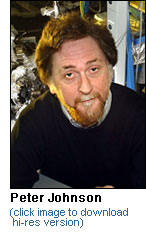Another Twist in the Field of Superconductivity
March 23, 2004
NOTE TO EDITORS: This press release describes a talk being given by a scientist from the U.S. Department of Energy's Brookhaven National Laboratory at the March 2004 meeting of the American Physical Society, taking place March 22-26 at the Palais de Congres, Montreal, Canada (http://www.aps.org/meet/MAR04/).
MONTREAL, CANADA - Researchers at the U.S. Department of Energy's Brookhaven National Laboratory have discovered an interesting type of electronic behavior in a recently discovered class of superconductors known as cobalt oxides, or cobaltates. These materials operate quite differently from other oxide superconductors, namely the copper oxides (or cuprates), which are commonly referred to as high-temperature superconductors.
When traditional superconductors are cooled to nearly absolute zero (0 Kelvin or -452 degrees Fahrenheit), pairs of negatively charged electrons exchange packets of vibrational energy known as phonons. This mechanism overcomes the repulsion of the like-charged particles and allows them to move together to carry electrical current with virtually no resistance. But the mechanism for superconductivity in the high-temperature cuprates - which act as superconductors at temperatures as "warm" as 138 K - is still one of the "hottest" mysteries in condensed matter physics. Above the superconducting transition temperature the cuprates do not exhibit normal electronlike behavior, so it's unclear either how or what is pairing to carry the current.
With the discovery of a new class of oxide superconductors, the cobaltates (which become superconducting at a temperature around 5 K), scientists were naturally curious whether they could learn something about their mechanism to shed light upon this problem. "What we've found," says Brookhaven physicist Peter Johnson, "has opened up another twist."
As Johnson's group cooled the cobalt-oxide materials, they observed electronlike excitations at temperatures well above the so-called transition temperature where the materials become superconductors. "If we had discovered these before we discovered the cuprates we'd probably think the same electron pairing mechanism was responsible for all superconductivity," Johnson says.
Johnson will explore the implications of this work in his talk during the session on "Novel and Complex Oxides IV" on Tuesday, March 23, at 2:42 p.m. in room 511E. This research is funded by the Office of Basic Energy Sciences within the Department of Energy's Office of Science.
2004-10115 | INT/EXT | Newsroom










